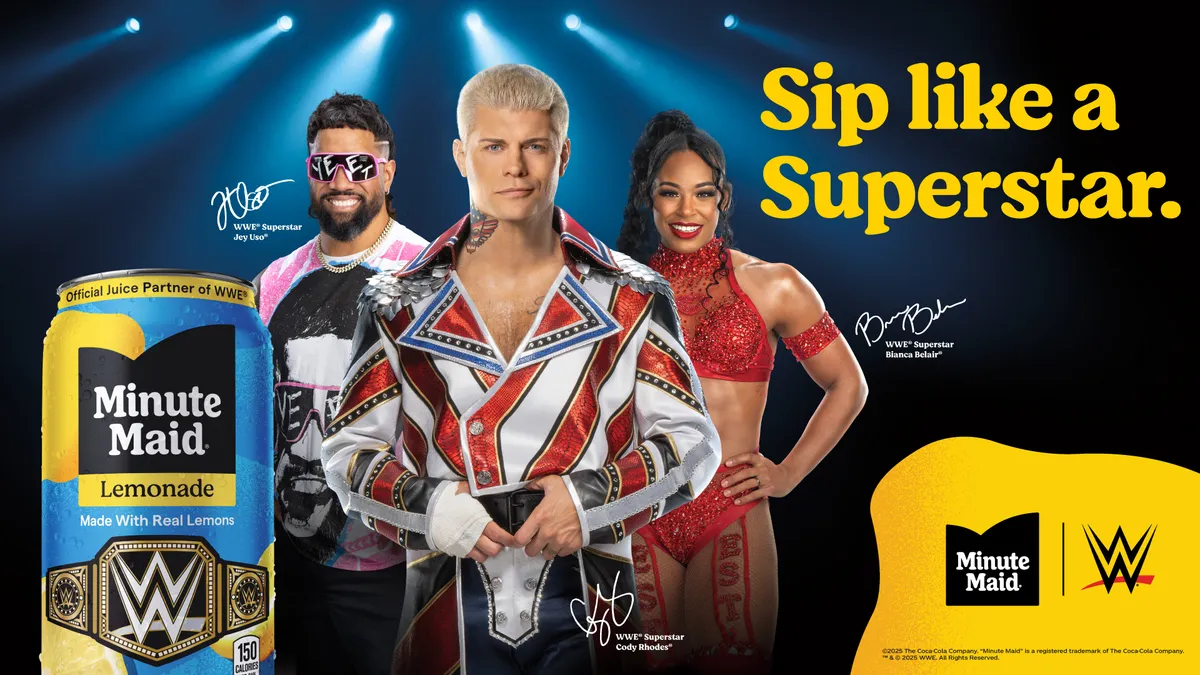In the last few years, social influencers have emerged as powerful media channels, and marketers are taking note.
In 2015, "you saw leading edge companies adopting influencer marketing ... and it's certainly not going to slow down any time soon," Chuck Moran, vp of marketing at RhythmOne, told Marketing Dive.
Partnering with influencers has proven to be a boon for marketers. Working with these next-generation celebrities brings a number of benefits, such as helping brands amplify their reach, target niche audiences, spur engagement, forge connections and build trust. According to RhythmOne’s “2015 1H Influencer Marketing Benchmarks Report,” imarketers that used influencer marketing saw a $9.60 return of earned media value (EMV) on average for every dollar of paid media spend.
“From a marketing perspective, for somebody that has to sell up, the fact they can go to the CFO or whomever is influencing the marketing budgets, they can say it pays off. They can say, ‘Look, where else am I get that kind of return?’” Moran said about the findings. “The return on investment is incredible and I think it's a trend we'll see continue.”
Despite the benefits, there's one big challenge that's stopping marketers from investing more in influencers — measurement. As the new media category gains in popularity, marketers looking to tap into the influencer marketplace will likely push for clearer insights. But there may be a solution to this problem, according to several experts Marketing Dive spoke with.
Word of mouth marketing 3.0
For Erich Joachimsthaler, founder and CEO of Vivaldi Partners Group consulting firm, influencer marketing is simply “a 3.0 version of what we used to call word of mouth.”
“We used to always talk about the power of word of mouth, and influencers are an exponentially more effective [version of it],” he told Marketing Dive.
According to a blog post by Ogilvy’s Andrew Barratt, “the history of influencer marketing, as an identifiable marketing theory, can be traced back to a 1940 study entitled ‘The People’s Choice’ by Lazerfeld & Katz.” Barratt explains that the study found that most people are influenced by secondhand and opinion leaders. Read: influencers.
In the past two years in particular, influencer marketing has seen significant growth, Joachimsthaler said, although it still has a ways to go before it is more widely adopted.
Where influencer marketing is catching on
From more traditional celebrity endorsers to today’s upstart Vine and Instagram stars, influencers take on the role of brand advocate when working on a campaign. Equipped with the knowledge that consumers are listen to these kinds of recommendations, more brands and agencies jumping on board — and seeing a positive return on investment.
For exanmple, an influencer campaign for Gap featuring Katie Rodgers of Paper Fashion and Pari Ehsan of Paridust – who each have over 600K and 200K followers on Instagram respectively – helped the retailer achieve an EMV of $18.05 for every dollar of paid media, RhythmOne reported in its "Influencer Marketing Solutions Showcase."
“In order to create really great content you need to create it from all different angles,” Moran said. “The world is so saturated, to stay relevant you [brands] need to … offer something unique and a different sort of expertise, and [influencer marketing is] a way for companies to cut through the noise.”
The category has even seeped into the work that veteran agencies are doing. Take for example, WPP’s media buying firm GroupM, which recently inked a deal with Fullscreen to give it exclusive access to the content creator network's social media influencer data.
“Influence has changed. New voices are needed for the digital generation. Celebrity ebbs and flows so much faster now and brands need to capture that flow and to exploit micro audience segments,” GroupM Chief Digital Officer Rob Norman said in a statement about the news. He explained to the Wall Street Journal that deal allows GroupM more “hands on” access when working with influencers.
Last year, digital agency Laundry Service spun off its own influencer network, Cycle, after seeing increased demand for social influencers from brands. Cycle, which started as a talent agency for influencers, now counts athletes like NBA player Russell Westbrook on its roster of 2,700 influencers and athletes.
Influencers are like media channels
Laundry Service CMO Mike Mikho told Marketing Dive that Cycle works like other media networks, in that “you pay for reach.” Cycle is currently producing 50,000-plus pieces of content a month that reach about 3 billion content views.
A change in the definition of media channels has helped influencer marketing find its footing in recent years. "People have become media channels. There’s no difference between ESPN's website and Russell Westbrook's Facebook page,” Mikho said, explaining both produce a high volume of content from sought after voices to large audiences. "When an individual has so many followers that they begin to rival traditional media players, they become influencers, and eyeballs are eyeballs, it's still the same process," he said.
An influencer’s value goes back to the question of reach. When vetting influencers to add to their roster, the main factor — in addition to follower count — they look at is the value add the influencer provides to their specific audience. For some followers, value add comes in the form of an inspiring photo or a hilarious video. In the case of athletes, for example, it might mean an authentic look into their daily life.
Compatability can be an issue. It wouldn't valuable for an influencer to work with a brand that isn’t relevant to their persona, for example. So when brands look to work with influencers, they take compatibility into consideration as well, Mikho said.
FameBit, a company that started as a self-service marketplace for YouTube endorsements and has since opened it up to Instagram, Tumblr, Vine, Facebook and and Twitter, is another example. Co-founder and COO Agnes Kozera told Marketing Dive they see the influencer space moving in the direction of being multi-channel, multi-platform.
“The way we're looking at influencer marketing is a comprehensive marketing strategy for brands … where you’re spreading your message across platforms, telling your story in different ways native and unique to the various platforms,” she said.
The value of influencer marketing comes from getting content from somebody who has a handle on how to create it, Kozera said, and perhaps more importantly, is plugged into an already-engaged audience to which they are distributing that content. “It allows you [brands] to position yourself for voice and search,” she said.
The measurement challenge
One of the biggest challenges social marketers run into – measurement – is a problem that keeps coming up.
Although RhythmOne’s report demonstrates influencer marketing has real ROI potential, a recent Forrester report, “The Right Way to Measure Social Marketing,” found that more than half (53%) of the marketers surveyed said measurement was their main challenge with social marketing. It was ranked higher than other challenges such as finding or creating content to publish (38%) or securing the budget for staff to manage online profiles (26%).
To make matters worse, marketers have been willing to accept whichever metrics vendors can provide for the social campaigns they're working on. Forrester’s research shows social marketers are willing to accept almost any metric – such as social posts and comments (34%), engagement rate (29%), social impressions (24%), social fans and followers (20%), sales (19%) and shares (10%) – to get even some idea of whether their efforts are paying off.
“This is one of the ugly parts of influencer marketing,” Vivaldi’s Joachimsthaler said. “I think marketers are not willing to take the risk of not receiving metrics. At least in my experience when we speak with clients about influencer marketing they roll their eyes saying ‘thanks so much for your promises,’ and it's very much a hard selling point.”
To complicate things further, the increased prominence of influencers means they are sometimes prominent across multiple platforms and channels. An early Instagram star, for example, may have moved over to YouTube when she saw that her short video clips on the app were gaining traction and wanted to try her luck at longform videos. If tracking metrics on one social platform wasn’t hard enough already, tracking them across platforms is even trickier — especially if you are looking for higher-level analytics that clearly prove ROI.
While “there's no way your message is worthless when you speak about it or get influencers to speak about it,” Joachimsthaler cautions that “just because you pay the influencer, it doesn’t mean they’re also helpful for you.”
“If you use a regular media channel you have much better metrics to make sure you get some sort of reach, impression or impact or engagement. If I go to the client and say I’m a digital agency and can get you this many retweets or shares, I think they need to be careful,” he said. At this point, “they’re pitching hope, but hope is not a strategy.”
“Engagement is a challenge,” FameBit’s Kozera said, admitting that it needs attention. But "you can’t measure everything with influencer marketing. A lot of it is about brand awareness and relevancy.”
FameBit tracks earned media from paid media on YouTube, for instance, but what they’re seeing is “brands getting more familiar with the overall and long-term value of influencer marketing and not being able to track everything,” she said. However, “the number one thing brands are worried about is how their content is getting engaged with.”
While FameBit's goal is to eventually provide higher-level analytics, it is currently teaching brands to look for different metrics, such as comments or “Likes,” that are akin to ROI because it shows the content is engaging and valuable to the audience.
If you look at influencer marketing in the context of being an integrated piece of your overall marketing plans, it increases in value, according to Joachimsthaler.
“When you are not measuring the effectiveness in isolation, you’re measuring the collective effort, which is more meaningful,” he said. “Influencer marketing is difficult, but it’s worth the investment.”
Finding a solution that sticks
“Maybe we're not asking the right question when we ask, ‘Is this measurable?’" Joachimsthaler said. "Maybe it should be, ‘What is the right combination of tools to connect with the consumer and should influencer marketing be part of it ?’ And the answer is yes.”
The solution to getting more marketers interested in influencer marketing, and being able to gather more viable metrics, lies in establishing guidelines. The FTC has established rules around advertising, but the rules that touch influencer marketing the closest — sponsored and native content — only apply to it tangentially.
Once there are better standards, influencer marketing will gain more ground, Joachimsthaler said.






















